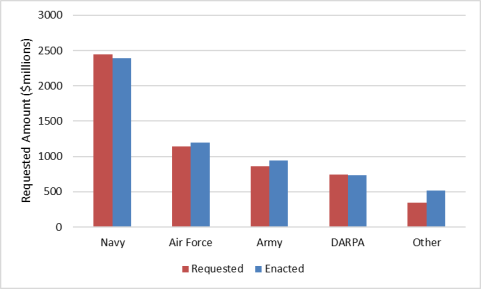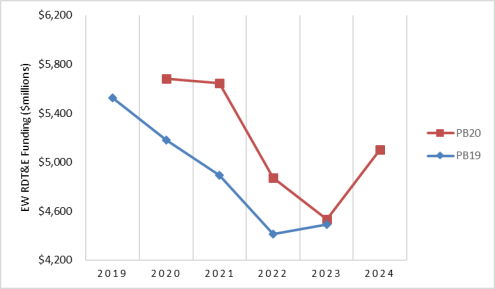The National Defense Strategy Commission identified Electronic Warfare (EW) as a critical capability to ensure the U.S. military remains competitive. In its FY2019 and FY2020 Defense Budget overview documents, the Department of Defense (DOD) identified EW as a priority to improve platform and network survivability; provide advanced jamming techniques to disrupt radars, communications, and command and control systems; and provide measures to defend the space domain and maintain power projection forces.
Even before the release of the Commission report, Congress showed an interest in EW programs. In 2015, the Deputy Secretary of Defense established the EW Executive Commission (EW EXCOM)—cochaired by the Under Secretary of Defense for Research and Engineering (USD R&E) and Vice Chairman of the Joint Chiefs of Staff—to identify emerging EW technologies. The FY2017 NDAA required the EW EXCOM to develop an EW Strategy; in its strategy, the EW EXCOM identified program elements and projects with EW facets in each of the services' and Defense-wide Research, Development, Test and Evaluation (RDT&E) appropriations. It did not identify procurement lines due to complexity and classification issues. Furthermore, some program elements the EXCOM identified might not fully provide EW capabilities, like Defense Advanced Research Projects Agency's (DARPA's) Electronics Technology. Other program elements which support EW operations, however, such as the Navy's E-2D Hawkeye, are not included in the EXCOM's program list. The following analysis compares the FY2019 budget request for these programs with the FY2020 request.
DOD views both RDT&E and procurement as investment dollars; therefore, to get a complete picture for DOD investments in EW programs, analysis should include both. However, in order to provide a timely comparison between the two budget requests, this article provides a comparison of RDT&E funding only. The analysis that follows includes funding for the Army, Navy, Air Force, DARPA, Defense Information Systems Agency (DISA), the Joint Staff, Office of the Secretary of Defense (OSD), Operational Test and Evaluation (OTE), and Special Operations Command (SOCOM), using program elements identified by EXCOM in its strategy document, which are aggregated at the department/agency level.
Table 1. FY2019 Requested and Future Year Funding for DOD Electronic Warfare RDT&E
(in millions of dollars)
|
|
|
|
Future Years
|
|
Department / Agency
|
FY2019
Request
|
FY2019
Enacted
|
FY2020
|
FY2021
|
FY2022
|
FY2023
|
Requested FYDP Total
|
|
Navy
|
2,443.0
|
2,393.5
|
2,345.7
|
2,090.4
|
1,611.9
|
1,417.0
|
9,908.1
|
|
Air Force
|
1,143.3
|
1,194.3
|
1,089.0
|
966.7
|
946.2
|
1,201.4
|
5,346.6
|
|
Army
|
859.7
|
945.5
|
621.0
|
581.1
|
576.3
|
528.5
|
3,166.6
|
|
DARPA
|
740.5
|
736.3
|
809.6
|
944.3
|
965.4
|
991.6
|
4,451.4
|
|
Other
|
341.0
|
520.6
|
312.7
|
311.4
|
313.8
|
351.7
|
1,630.6
|
|
Total
|
5,527.5
|
5,790.2
|
5,178.0
|
4,894.0
|
4,413.6
|
4,490.1
|
24,503.3
|
Source: Air Force FY2019 Research, Development Test and Evaluation Budget Justification Volume 1-3b, Army FY2019 Research, Development Test and Evaluation Budget Justification Volume 1-5, Navy FY2019 Research, Development Test and Evaluation Budget Justification Volume 1-5, Defense-wide FY2019 Research, Development Test and Evaluation Budget Justification Volume 5, Air Force FY2020 Research, Development Test and Evaluation Budget Justification Volume 1-3b, Army FY2020 Research, Development Test and Evaluation Budget Justification Volume 1-5, Navy FY2020 Research, Development Test and Evaluation Budget Justification Volume 1-5, Defense-wide FY2020 Research, Development Test and Evaluation Budget Justification Volume 5.
Notes: The "Other" category combines funding from DISA, Joint Staff, OSD, OTE, and SOCOM. Data reported from the EW EXCOM and compiled by the Association of the Old Crows based on EW EXCOM designated Program Elements and Projects. The "FY2019 Enacted" column is derived from the FY2020 budget request.
Table 1 provides an overview of the FY2019 EW RDT&E funding request, FY2019 enacted funding, as well as projected funding for EW program elements in each of the departments and agencies. The FY2019 request serves as a mechanism to compare how DOD changed its funding priorities for FY2020. Of note, DOD requested $5.5 billion in EW RDT&E for FY2019, and planned on spending approximately $24.5 billion across the Future Years Defense Program (FYDP). The Navy requested the most funding in FY2019 ($2.4 billion), followed by the Air Force ($1.1 billion), the Army ($860 million), and other organizations ($1.08 billion). EW funding was anticipated to peak in FY2019 and to begin to curtail through FY2022, followed by a slight increase in FY2023 (see Figure 2).
|
Figure 1. FY2019 EW RDT&E Requested and Enacted Funding
FY2019 Requested and Enacted Funding
|
 |
|
Source: Air Force FY2019 Research, Development Test and Evaluation Budget Justification Volume 1-3b, Army FY2019 Research, Development Test and Evaluation Budget Justification Volume 1-5, Navy FY2019 Research, Development Test and Evaluation Budget Justification Volume 1-5, Defense-wide FY2019 Research, Development Test and Evaluation Budget Justification Volume 5, Air Force FY2020 Research, Development Test and Evaluation Budget Justification Volume 1-3b, Army FY2020 Research, Development Test and Evaluation Budget Justification Volume 1-5, Navy FY2020 Research, Development Test and Evaluation Budget Justification Volume 1-5, Defense-wide FY2020 Research, Development Test and Evaluation Budget Justification Volume 5.
Notes: The "Other" category combines funding from DISA, Joint Staff, OSD, OTE, and SOCOM. Data reported from the EW EXCOM and compiled by CRS. Values presented are in nominal dollars.
|
Figure 1 shows the difference between the Administration's FY2019 DOD request and congressional action on EW RDT&E. DOD requested a total of approximately $5.5 billion in FY2019; Congress enacted approximately $5.8 billion, $263 million above the requested amount. The largest increases between FY2019 request and enacted levels were for "Other" agencies—primarily Operational Test and Evaluation—and the Army. The Navy and DARPA saw a slight decreases from their requested levels.
Table 2. FY2020 Requested and Projected Funding for DOD Electronic Warfare RDT&E
(in millions of dollars)
|
|
|
Future Years
|
|
Department / Agency
|
FY2020
|
FY2021
|
FY2022
|
FY2023
|
FY2024
|
FYDP Total
|
|
Navy
|
2,507.6
|
2,402.0
|
1,920.3
|
1,566.6
|
1,554.7
|
9,951.2
|
|
Air Force
|
1,176.3
|
1,137.2
|
1,029.4
|
1,063.3
|
1,683.6
|
6,089.8
|
|
Army
|
915.6
|
861.7
|
635.4
|
589.2
|
536.2
|
3,538.2
|
|
DARPA
|
690.6
|
880.7
|
921.7
|
957.6
|
981.5
|
4,432.2
|
|
Other
|
391.5
|
361.6
|
362.6
|
357.3
|
344.1
|
1,817.1
|
|
Total
|
5,681.5
|
5,643.2
|
4,869.5
|
4,534.0
|
5,100.2
|
25,828.5
|
Source: Air Force FY2020 Research, Development Test and Evaluation Budget Justification Volume 1-3b, Army FY2020 Research, Development Test and Evaluation Budget Justification Volume 1-5, Navy FY2020 Research, Development Test and Evaluation Budget Justification Volume 1-5, Defense-wide FY2020 Research, Development Test and Evaluation Budget Justification Volume 5.
Notes: The "Other" category combines funding from DISA, Joint Staff, OSD, OTE, and SOCOM. Data analyzed by CRS.
Table 2 provides FY2020 request and projected future year funding levels for EW RDT&E appropriations as provided in DOD's FY2020 budget request. Of particular note, the Administration's DOD budget requested $504 million in additional RDT&E funding for FY2020 compared to the FY2019 request. While it would follow a trend line similar to last year's projection, DOD's plan adds additional money to EW capabilities in each year in the out years of the FYDP. This can largely be attributed to the Navy's start of the Next Generation Jammer-Low Band program, as well as the Army's renewed focus on EW capabilities.
|
Figure 2. Planned EW RDT&E Funding in the FY2019 and FY2020 DOD Budget Requests
|
 |
|
Source: Air Force FY2019 Research, Development Test and Evaluation Budget Justification Volume 1-3b, Army FY2019 Research, Development Test and Evaluation Budget Justification Volume 1-5, Navy FY2019 Research, Development Test and Evaluation Budget Justification Volume 1-5, Defense-wide FY2019 Research, Development Test and Evaluation Budget Justification Volume 5, Air Force FY2020 Research, Development Test and Evaluation Budget Justification Volume 1-3b, Army FY2020 Research, Development Test and Evaluation Budget Justification Volume 1-5, Navy FY2020 Research, Development Test and Evaluation Budget Justification Volume 1-5, Defense-wide FY2020 Research, Development Test and Evaluation Budget Justification Volume 5.
Notes: The "Other" category combines funding from DISA, Joint Staff, OSD, OTE, and SOCOM. Data reported from the EW EXCOM and compiled by CRS. Values presented are in nominal (or current) dollars.
|
Figure 2 shows the differences between DOD's projected EW RDT&E funding from the FY2019 FYDP and the FY2020 FYDP. In total, DOD added more than $1 billion across the out-years, compared with the FY2019 request. The largest additions occur in FY2020 and FY2021, before returning to planned spending in FY2023. The decline in EW RDT&E is caused by programs—such as the Navy's Next Generation Jammer and the Army's assured positioning, navigation, and timing antennas—moving from RDT&E to procurement.
Issues for Congress
DOD has given heightened priority to EW RDT&E funding in its FY2020 budget, increasing planned EW RDT&E funding from $5.2 billion in its FY2019 request to $5.7 billion in its FY2020 request. This represents a 9.7% increase, which is nearly double the 5% increase in overall DOD funding from FY2019 to FY2020.
Some have argued that DOD has not given adequate priority to EW over the past several years. These budget projections may support the argument that DOD is now beginning to prioritize investment in EW funding. Congress may consider whether current EW funding levels are sufficient and if Congress believes more funding is needed for EW, it could opt to add new funding to the current RDT&E and procurement budgets or reallocate funding from lower priority program elements.
DOD reports procurement programs as line items and often does not link these line items to the specific RDT&E program element. If EW funding remains a continuing congressional interest, Congress could require DOD to report EW funding across each of the military departments or agencies.

